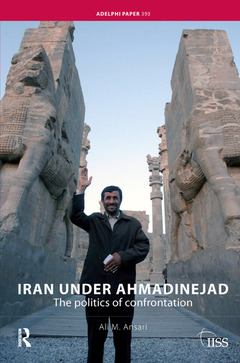Description
Iran under Ahmadinejad
The Politics of Confrontation
Adelphi Series
Author: Ansari Ali M.
Language: English
Subjects for Iran under Ahmadinejad:
Keywords
IRGC; Guardian Council; islamic; Mohammad Khatami; republic; Hardline Critics; Iran Libya Sanctions Act; UN; Islamic Republic; Iran Iraq War; Tehran City Council; Hardline Conservatives; Hassan Rowhani; Mahmoud Ahmadinejad; Islamic Revolution; President Hashemi Rafsanjani; Khatami’s Presidency; Ayatollah Khamenei; Ahmadinejad Presidency; Majlis Elections; Iran’s Nuclear Weapons Programme; Mehdi Karrubi; Ardebil Province; Iran’s Neo-conservatives; President’s Allies; Chain Murders; Basij Militia
Publication date: 06-2017
· 15.6x23.4 cm · Hardback
Publication date: 01-2008
104 p. · 15.6x23.4 cm · Paperback
Description
/li>Contents
/li>Readership
/li>Biography
/li>
The election of Mahmoud Ahmadinejad to the presidency of the Islamic Republic of Iran in the summer of 2005 thrust Iran into the international limelight in a way that few would have predicted. Robust, confrontational and given to bombastic rhetoric, Ahmadinejad has drawn condemnation from the West and praise from the Middle Eastern street in almost equal measure.
This Paper looks at the details of his political rise and assesses his presidency to date within the context of the dynamics of Iranian politics. Examining the key themes of his presidency, it assesses the effectiveness of his policies and analyzes his populist approach, in particular his use of nationalism and the cult of the Twelfth Imam. The author argues that Ahmadinejad, far from retrenching the conservative values of the early revolution, is very much a product of the social and political changes which have occurred since the end of the Iran Iraq War; that his populism in both politics and economics, along with the maintenance of a confrontational posture abroad, represents an ad hoc, and somewhat incoherent, attempt to disguise the growing contradictions which afflict the Islamic Republic, and the conservative vision of an unaccountable Islamic autocracy in the face of growing dissatisfaction, especially among key sections of thete.




